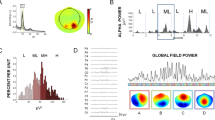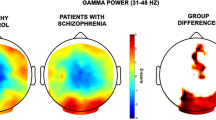Abstract
The rest states with the eyes open (RSEO) and closed (RSEC) were subjected to quantitative EEG study as states similar in the pattern of mental activity and subjective assessments but different in the EEG pattern. The mean values of the spectral power and EEG coherence function were compared in 74 subjects for the following bands: Δ, ϑ, α1, α2, β1, β2, and γ. Upon the transition from the RSEC to the RSEO, the EEG local power significantly decreased over the whole cortex for the α, ϑ, and β bands. A simultaneous decrease in the EEG power in all the bands (including β and γ) was most pronounced (as judged by relative changes and tests of significance of difference) in the parietooccipital derivations immediately related to the cortical zones where an increase in the neuronal activity upon opening the eyes is most probable. A significant increase in the EEG power was observed only for the γ band in frontal derivations F 3 and F 4. Significant differences in the mean EEG coherence in the RSEO-RSEC comparison were present in many derivation pairs, especially in the α2, β1, β2, and γ bands. For each of these bands, the number of differences determined on the basis of Fisher test was more than 70% of the maximum possible number. In the overwhelming majority of cases, the coherence was lower in the RSEO; however, in the caudal cortical zones, a higher coherence in the α1, ϑ, and Δ bands in the RSEO was rather typical. The results confirmed that the two states under study differ in a number of averaged EEG parameters with high statistical significance and may be used as reference states during performance of tasks with the eyes open and closed, respectively. The differences between the RSEC and the RSEO may be caused by the fact that the RSEC is a functional state oriented predominantly to the analysis of internal information (internally oriented), and the RSEO, predominantly to the analysis of information coming from the outside (externally oriented). The pattern of the observed EEG differences points to a combination of effects both localized in the visual zone and reflecting changes in the network cortical activity, i.e., simultaneous, although nonuniform, changes over all the main zones of the cortex. Comparison of the results with published estimations of differences in the local cerebral blood flow (ICBF) between the RSEO and the RSEC shows that increase in the ICBF may be associated with a local decrease in the EEG spectral power in any frequency band, including the high-frequency β and γ bands, or several frequency bands simultaneously.
Similar content being viewed by others
References
Niedermeyer, E., The Normal EEG of the Waking Adult, Electroencephalography. Basic Principles, Clinical Applications, and Related Fields, Niedermeyer, E. and Lopes da Silva, F.H., Eds., 3d ed., London: Williams and Wilkins, 1995, p. 149.
Steriade, M. and Amzica, F., Intracortical and Corticothalamic Coherency of Fast Spontaneous Oscillations, Proc. Natl. Acad. Sci. USA, 1996, vol. 93, no. 6, p. 2533.
Pulvermuller, F., Birbaumer, N., Lutzenberger, W., and Mohr, B., High-Frequency Brain Activity: Its Possible Role in Attention, Perception and Language Processing, Progr. Neurobiol., 1997, vol. 52, no. 5, p. 427.
Steriade, M., Corticothalamic Resonance, States of Vigilance and Mentation, Neuroscience, 2000, vol. 101, no. 2, p. 243.
Karakas, S., Basar-Eroglu, C., Ozesmi, C., et al., Gamma Response of the Brain: a Multifunctional Oscillation that Represents Bottom-up with Top-down Processing, Int. J. Psychophysiol., 2001, vol. 39, nos. 2–3, p. 137.
Danilova, N.N., Functional States, Psikhofiziologiya: Uchebnik dlya vuzov (Psychophysiology: A Text-Book for Higher School), Aleksandrov, Yu.I., Ed., St. Petersburg: Piter, 2003, second edition, p. 166.
Livanov, M.N., Prostranstvennaya organizatsiya protsessov golovnogo mozga (Spatial Organization of the Brain Processes), Shuranova, Zh.P., Ed., Moscow: Nauka, 1972.
Sviderskaya, N.E., Sinkhronnaya elektrichaskaya aktivnost’ mozga i psikhicheskie protsessy (Synchronous Electrical Activity of the Brain and Mental Processes), Moscow: Nauka, 1987.
Elul, R., The Genesis of the EEG, Int. Rev. Neurobiol., 1972, vol. 15, no. 2, p. 227.
Zhadin, M.N., Biofizicheskie mekhanizmy formirovaniya elektroentsefalogrammy (Biophysical Mechanisms of the Electroencephalogram Formation), Moscow: Nauka, 1984.
Lopes da Silva, F., Neural Mechanisms Underlying Brain Waves: From Neural Membranes to Networks, EEG and Clin. Neurophysiol., 1991, vol. 79, no. 2, p. 81.
Osovets, S.M., Ginzburg, D.A., Gurfinkel’, V.S., et al., Electrical Brain Activity: Mechanisms and Interpretation, Usp. Fiziol. Nauk, 1983, vol. 141, no. 1, p. 103.
Matsuoka, S., Theta Rhythms: State of Consciousness, Brain Topogr., 1990, vol. 3, no. 1, p. 203.
Basar, E., Schurmann, M., Basar-Eroglu, C., and Karakas, S., Alpha Oscillations in Brain Functioning: An Integrative Theory, Int. J. Psychophysiol., 1997, vol. 26, nos. 1–3, p. 5.
Niedermeyer, E., Alpha Rhythms as Physiological and Abnormal Phenomena, Int. J. Psychophysiol., 1997, vol. 26, nos. 1–3, p. 31.
Klimesch, W., EEG Alpha and Theta Oscillations Reflect Cognitive and Memory Performance: A Review and Analysis, Brain Res. Brain Res. Rev., 1999, vol. 29, nos. 2–3, p. 169.
Nunez, P.L., Generation of Human EEG by a Combination of Long-and Short-Range Neocortical Interactions, Brain Topography, 1989, vol. 1, p. 199.
Nunez, P.L., Toward a Quantitative Description of Large Scale Neocortical Dynamic Function and EEG, Behav. Brain Sci., 2000, vol. 23, no. 3, p. 371.
Raichle, M.E., MacLeod, A.M., Snyder, A.Z., et al., A Default Mode of Brain Function, Proc. Natl. Acad. Sci. USA, 2001, vol. 98, no. 2, p. 676.
Gusnard, D.A. and Raichle, M.E., Searching for a Baseline: Functional Imaging and the Resting Human Brain, Natl. Rev. Neurosci., 2001, vol. 2, p. 685.
Feige, B., Scheffler, K., Esposito, F., et al., Cortical and Subcortical Correlates of Electroencephalographic Alpha Rhythm Modulations, J. Neurophysiol., 2005, vol. 93, no. 5, p. 2864.
Berger, H., Uber das Elektrenkephalogramm des Menschen, Arch. Psychiatr. Nervenkr., 1929, vol. 87, p. 527.
Berger, H., Uber das Elektrenkephalogramm des Menschen II, J. Psychol. Neurol., 1930, vol. 40, p. 160.
Ristanovic, D., Martinovic, Z.J., and Jovanovic, V., Topography of Visual EEG Reactivity in School-Age Children. Brain Dev., 1999, vol. 21, no. 4, p. 236.
Motokizawa, F. and Fujimori, B., Fast Activities and DC Potential Changes of the Cerebral Cortex during EEG Arousal Response, EEG and Clin. Neurophysiol., 1964, vol. 17, p. 630.
Volavka, J., Matousek, M., and Roubicek, J., Mental Arithmetic and Eye Opening. An EEG Frequency Analysis and GSR Study, EEG and Clin. Neurophysiol., 1967, vol. 22, p. 174.
Etevenon, P., Tortrat, D., and Benkelfat, C., Electroencephalographic Cartography. II. By Means of Statistical Group Studies-Activation by Visual Attention, Neuropsychobiology, 1985, vol. 13, no. 3, p. 141.
Etevenon, P., Eustache, F., Mitermite, F., et al., EEG Cartography before and after Visual Stimulation: A Group Study with Descriptive Non-Parametric Analysis of EEG Data, Brain Topogr., 1990, vol. 3, no. 1, p. 13.
Sterman, M., Mann, C., Kaiser, D., and Suyenobu, B., Multiband Topographic EEG Analysis of a Simulated Visuomotor Aviation Task, Int. J. Psychophysiol., 1994, vol. 16, no. 1, p. 49.
Doppelmayr, M., Klimesch, W., Schwaiger, J., et al., Theta Synchronization in the Human EEG and Episodic Retrieval, Neurosci. Lett., 1998, vol. 257, no. 1, p. 41.
Grunwald, M., Weiss, T., Krause, W., et al., Power of Theta Waves in the EEG of Human Subjects Increases during Recall of Haptic Information, Neurosci. Lett., 1999, vol. 260, no. 3, p. 189.
Pollock, V.E., Schneider, L.S., and Lyness, S.A., Reliability of Topographic Quantitative EEG Amplitude in Healthy Late-Middle-Aged and Elderly Subjects, EEG and Clin. Neurophysiol., 1991, vol. 79, no. 1, p. 20.
Funktsional’nye sostoyaniya mozga (Functional States of the Brain), Sokolov, E.N., Danilova, N.N., and Khomskaya, E.D., Eds., Moscow: Mosk. Gos. Univer., 1975.
Moruzzi, G. and Magoun, H.W., Brain Stem Reticular Formation and Activation of the EEG, EEG and Clin. Neurophysiol., 1949, vol. 1, p. 455.
Dement, W. and Kleitman, N., Cyclic Variations in EEG during Sleep and Their Relation to Eye Movements, Body Motility, and Dreaming, EEG and Clin. Neurophysiol., 1957, vol. 9, p. 673.
Tanaka, H., Hayashi, M., and Hori, T., Topographical Characteristics and Principal Component Structure of the Hypnagogic EEG, Sleep, 1997, vol. 20, p. 523.
Ray, W.J. and Cole, H.W., EEG Alpha Activity Reflects Attentional Demands and Beta Activity Reflects Emotional and Cognitive Processes, Science, 1985, vol. 228, no. 4700, p. 750.
Danko, S.G., Bechtereva, N.P., Shemyakina, N.V., and Antonova, L.V., Electroencephalographic Correlates of Mental Performance of Emotional Personal and Scenic Situations: I. Characteristics of Local Synchronization, Fiziol. Chel., 2003, vol. 29, no. 3, p. 5.
Cooper, N.R., Croft, R.J., Dominey, S.J., et al., Paradox Lost? Exploring the Role of Alpha Oscillations during Externally vs. Internally Directed Attention and the Implications for Idling and Inhibition Hypotheses, Int. J. Psychophysiol., 2003, vol. 47, p. 65.
Cantero, J.L., Atienza, M., Madsen, J.R., and Stickgold, R., Gamma EEG Dynamics in Neocortex and Hippocampus during Human Wakefulness and Sleep, Neuroimage, 2004, vol. 22, no. 3, p. 1271.
Yanson, Z.A., The Effect of the Mesencephalic Reticular Formation on the Spatial Synchronization of Brain Biopotentials, Zh. Vyssh. Nerv. Deyat. im. I.P. Pavlova, 1973, vol. 23, no. 1, p. 59.
Sviderskaya, N.E. and Korol’kova, T.A., Spatial Synchronization of the Electrical Processes of the Brain: Problems and Solutions, Zh. Vyssh. Nern. Deyat. im. I.P. Pavlova, 1997, vol. 47, no. 5, p. 792.
Kiroi, V.N., Spatiotemporal Organization of the Human Brain Electrical Activity in the State of Quiet Wakefulness and During Performance of Mental Tasks, Zh. Vyssh. Nerv. Deyat. im. I.P. Pavlova, 1987, vol. 37, no. 6, p. 1025.
Bechtereva, N.P., Danko, S.G., Starchenko, M.G, et al., Study of the Brain Organization of Creativity: III. Brain Activation by the Data of the Analysis of the Local Cerebral Blood Flow and EEG, Fiziol. Chel., 2001, vol. 27, no. 4, p. 6.
von Stein, A. and Sarnthein, J., Different Frequencies for Different Scales of Cortical Integration: From Local Gamma to Long Range Alpha/Theta Synchronization, Int. J. Psychophysiol., 2000, vol. 38, no. 3, p. 301.
Cantero, J.L., Atienza, M., Salas, R.M., and Gomez, C.M., Alpha EEG Coherence in Different Brain States: An Electrophysiological Index of the Arousal Level in Human Subjects, Neurosci. Lett., 1999, vol. 271, no. 3, p. 167.
Hobson, J.A., Pace-Schott, E.F., and Stickgold, R., Dreaming and the Brain: Toward a Cognitive Neuroscience of Conscious States, Behav. Brain Sci., 2000, vol. 23, no. 6, p. 793.
Anokhin, P.K., Uzlovye voprosy teorii funktsional’nykh sistem (Key Problems of the Theory of Functional Systems), Moscow: Nauka, 1980.
Logothetis, N.K., The Neural Basis of the Blood-Oxygen-Level-Dependent Functional Magnetic Resonance Imaging Signal, Philos. Trans. R. Soc. Lond. B. Biol. Sci., 2002, vol. 357, no. 1424, p. 1003.
Logothetis, N.K. and Wandell, B.A., Interpreting the BOLD Signal, Ann. Rev. Physiol., 2004, vol. 66, p. 735.
Author information
Authors and Affiliations
Additional information
Original Russian Text © S.G. Danko, 2006, published in Fiziologiya Cheloveka, 2006, Vol. 32, No. 4, pp. 5–17.
Rights and permissions
About this article
Cite this article
Danko, S.G. The reflection of different aspects of brain activation in the electroencephalogram: Quantitative electroencephalography of the states of rest with the eyes open and closed. Hum Physiol 32, 377–388 (2006). https://doi.org/10.1134/S0362119706040013
Received:
Issue Date:
DOI: https://doi.org/10.1134/S0362119706040013




